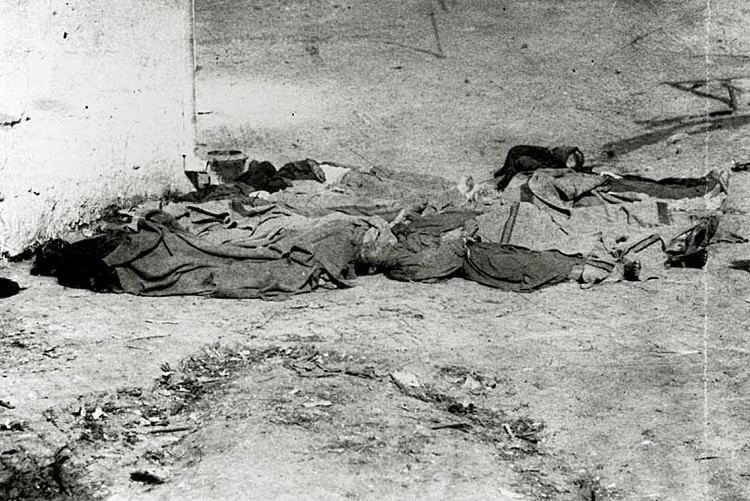Date October 24, 1871 Attack type Massacre | Target Chinese immigrants Deaths 17 to 20 | |
 | ||
Location Los Angeles, California, U.S. Perpetrators Mob of around 500 white men | ||
The Chinese massacre of 1871 was a racially motivated riot which occurred on October 24, 1871 in Los Angeles, California, when a mob of around 500 white men entered Chinatown to attack, rob, and murder Chinese residents of the city. The massacre took place on Calle de los Negros (Street of the Negroes), also referred to as "Nigger Alley", which later became part of Los Angeles Street. An estimated 17 to 20 Chinese immigrants were systematically tortured and then hanged by the mob, making the event the largest mass lynching in American history.
Contents
Riot and massacre
The riot and massacre were allegedly triggered by the killing of Robert Thompson, a local rancher, who was caught in the cross-fire during a gun battle between two Chinese factions. This fight was part of a longstanding feud over the abduction of a Chinese woman named Yut Ho.
The dead Chinese in Los Angeles were hanging at three places near the heart of the downtown business section of the city; from the wooden awning over the sidewalk in front of a carriage shop; from the sides of two “prairie schooners” parked on the street around the corner from the carriage shop; and from the cross-beam of a wide gate leading into a lumberyard a few blocks away from the other two locations. One of the victims was hanged without his trousers and minus a finger on his left hand.
Practically every Chinese-occupied building on the block was ransacked and almost every resident was attacked or robbed. A total of 18 Chinese immigrants were tortured and then hanged by the mob, making the event the largest mass lynching in American history.
Location
Calle de los Negros was situated immediately northeast of Los Angeles’s principal business district, running 500 feet (150 m) from the intersection of Arcadia Street to the plaza. The unpaved street took its name from the Californios (pre-annexation, Spanish-speaking Californians) of darker-complexion (most likely of mixed race: Spanish and Native American) who had originally lived there. Once home to the town’s most prominent families, the neighborhood had deteriorated into a slum by the time Los Angeles’s first Chinatown was established there in the 1860s.
Los Angeles merchant and memoirist Harris Newmark recalled that Calle de los Negros was “as tough a neighborhood, in fact, as could be found anywhere.” Los Angeles historian Morrow Mayo described it as
a dreadful thoroughfare, forty feet wide, running one whole block, filled entirely with saloons, gambling-houses, dance-halls, and cribs. It was crowded night and day with people of many races, male and female, all rushing and crowding along from one joint to another, from bar to bar, from table to table. There was a band in every joint, with harps, guitars, and other stringed instruments predominating.
Calle de los Negros was incorporated into Los Angeles Street in 1877. The adobe apartment block where the Chinese massacre occurred was torn down in the late 1880s. Today, the location is part of El Pueblo de Los Ángeles Historical Monument.
Causes
A growing movement of anti-Chinese discrimination in California climaxed in the passage of the Chinese Exclusion Act of 1882.
Aftermath
Only ten rioters were ever brought to trial. Eight were convicted, but their convictions were overturned on a legal technicality. The eight convicted of manslaughter and sentenced to imprisonment in San Quentin were:
The event was well-reported on the East Coast as newspapers there labeled Los Angeles a "blood stained Eden" after the riots.
Representation in literature
Alejandro Morales recounts the massacre in his novel The Brick People (1988).
